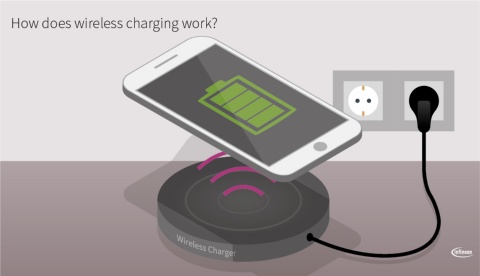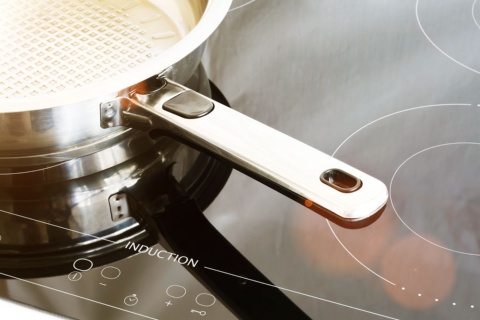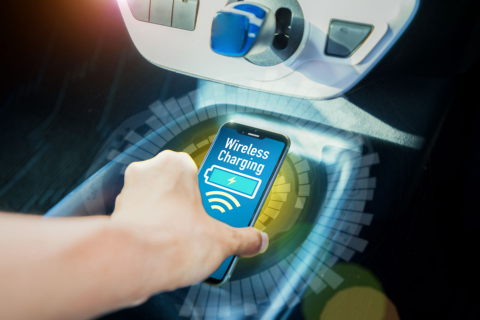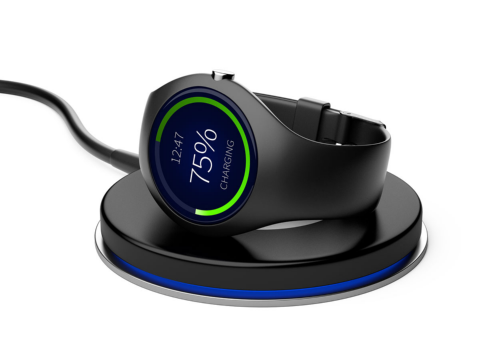자료실
[해외칼럼] 무선충전-유도식 충전의 작동원리 및 올바른 사용방법
- 작성일2022/10/05 17:28
- 조회 406
[번역요약]
무선 충전은 어떻게 작동할까요?
무선 충전은 케이블 없이 작동하는 것이 아니라, 충전기에 연결된 전원 케이블을 콘센트에 연결해야 하지만, 스마트폰은 충전기에 올려놓기만 하면 됩니다.
충전기에 포함된 코일을 통해서 교류 전류가 흘러 자기장을 발생시키고, 스마트폰이 자기장 범위 안에 들어오면 충전이 이루어지는 원리입니다.
무선 충전에는 두 가지 방식이 있는데, 유도식 충전과 공진식 충전입니다.
유도식 충전과 공진식 충전
유도식 충전은 인근의 금속에서 변화하는 자기장이 전류를 발생시키는 것을 말합니다.
예를 들자면, 인덕션 스토브는 쿡탑의 코일이 변화하는 자기장을 발생시키고, 이를 통해서 냄비 바닥으로 전기가 흐르게 되어 냄비 바닥이 뜨거워지는 것입니다.
스마트폰의 경우에는 빠르게 변화하는 전류를 적절한 회로를 사용해 균일한 전류로 변환하여 배터리를 충전합니다.
공진식 충전은 무선 충전을 확장한 형태로, 충전기 코일과 디바이스 코일 사이에 하나 이상의 공진 회로를 사용합니다.
이것은 콘덴서와 코일로 이루어진 전기 회로로서, 애플리케이션에 따라서 적합하게 적용될 수 있습니다. 이 방식은 유도식 충전에 비해서 다음과 같은 장점이 있습니다.
- 한꺼번에 여러 개의 디바이스를 충전할 수 있음
- 충전기 위에 디바이스를 꼭 정확하게 올려놓지 않아도 됨
- 충전기와 디바이스 사이에 거리가 멀어도 충전이 가능함
- 더 높은 효율로 더 많은 에너지가 배터리에 도달함
하지만 공진식 충전은 유도식 충전에 비해 더 많은 부품이 필요하기 때문에 비용이 더욱 커집니다.
무선 충전 장치들과 장점
무선 충전은 스마트폰뿐만 아니라 스마트워치 같은 기타 웨어러블, 노트북, 전동 공구, 진공청소기, 잔디깎이, 드론 등 많은 장치에 사용되고 있는데, 다음과 같은 이점들을 제공합니다.
- 더 간단하고 편함
- 충전기가 항상 같은 자리에 있다면, 충전 케이블을 찾을 필요가 없음
- 공공장소에 설치되어 있는 충전기로 집 밖에서도 스마트폰을 편리하게 충전할 수 있음
- 충전 소켓을 자주 사용하지 않아 마모나 파손을 줄일 수 있음
- 충전 소켓이 없어도 되므로 스마트폰 내부로 물이나 오염물질이 유입되는 위험성이 줄어듦
의료 분야에서도 유용하게 사용할 수 있습니다. 충전 케이블을 위한 소켓이 필요 없는 장비는 더 쉽게 소독할 수 있고, 케이블이 바닥에 어지럽게 널려 있지 않을 것입니다.
전기차도 무선 충전을 할 수 있습니다. 다만, 훨씬 많은 에너지를 전송해야 합니다.
Qi 충전기가 무엇일까요?
무선 충전을 사용하면 사용자들이 더 이상 각기 다른 모델의 스마트폰마다 각기 다른 충전기를 사용할 필요가 없습니다.
업계에서 조기 단계에 다수의 표준을 논의했으며, 지금은 유도식 충전용으로 Qi 표준이 자리를 잡고 있습니다.
Qi 국제 표준
이 산업 표준은 WPC (Wireless Power Consortium)에서 제정한 것으로서, WPC에는 삼성과 애플 같은 회사들이 참여하고 있습니다.
Qi 표준은 충전기와 충전하고자 하는 디바이스가 충족해야 하는 기술 요건들을 정의합니다. 예를 들어서 Qi를 적용한 충전기는 Qi를 지원하는 어느 스마트폰이나 충전할 수 있습니다.
또한, 구형 스마트폰은 특수한 스마트폰 커버나 스티커를 사용해서 Qi 표준을 지원하도록 업그레이드할 수 있습니다.
유도식 충전기의 사용 방법 및 사용 시 고려사항
유도식 충전기의 사용 방법은 스마트폰을 충전기 위에 올려놓기만 하면 됩니다.
다만, 스마트폰에 있는 코일과 충전기에 있는 코일이 정확한 위치에 놓여야만 충전 프로세스가 작동되며, 두 코일 간의 거리가 떨어지면 충전이 중단됩니다.
대부분의 무선 충전기는 이것을 방지하기 위해 충전기의 표면을 미끄럼 방지 소재로 만들거나, 자석을 사용하기도 합니다.
충전 성능 향상을 위해 다수의 코일을 사용하기도 합니다. 그러면 스마트폰을 충전기 위에 올려놓을 때 좀 더 편하게 올려 놓을 수 있으며,
충전기에 따라서 스마트폰이나 스마트 워치 등 여러 디바이스를 동시에 충전할 수 있습니다.
하지만 이것은 하나의 코일을 사용하는 것에 비해서 훨씬 값이 비싸기 때문에 주로 자동차에 사용되고 있습니다.
대부분의 무선 충전기는 5W 전력을 제공하는데, 유선 충전기는 평균 10W 이상 전력을 제공합니다. 하지만 Qi 표준을 사용하는 충전기는 최대 15W의 급속 충전을 지원합니다.
무선 충전 중에는 스마트폰 이동이 제한되어 사용할 수 있는 기능 또한 제한될 수 있습니다. 하지만 스마트폰을 특정 각도로 올려놓을 수 있는 충전기를 사용한다면 충전하는 동안에 영화를 보는 것이 가능해집니다.
만약 배터리 충전 상태를 확인하기 위해서 스마트폰을 충전기로부터 들어올려야 한다면 충전이 중단될 것입니다.
그렇기 때문에 많은 충전기는 LED를 사용해서 사용자가 디바이스를 움직이거나 들어 올릴 필요 없이 충전 상태를 확인할 수 있습니다.
무선 충전의 위험성
무선 충전기는 차폐가 되므로 자기장 범위가 매우 제한적이며 특정한 방향을 향하도록 설계됩니다. 또한 스마트폰은 자기장이 약하며, 이를 충전할 때만 자기장이 발생합니다.
금속성 이물질은 위험할 수 있습니다. 이물질이 인덕션 쿠커와 같은 원리로 충전 코일의 자기장 범위 내에 들어갔을 때 매우 뜨거워질 수 있습니다.
하지만 이를 보완한 “스마트” 충전기가 이미 출시되고 있습니다. 이러한 충전기는 스마트폰과 접촉 표면 사이에 이물질이 존재할 때 이를 감지하고 충전을 중단시킵니다.
무선 충전의 미래
무선 충전을 도입하는 디바이스는 점점 더 늘어날 것으로 보이며, 더 빠른 급속 충전이 가능해진다면 그 수요는 더욱 증가할 것입니다.
스마트폰을 필두로 헤드폰, 스마트 워치, 피트니스 트래커뿐만 아니라 맥박 조정기 같은 저전력 의료 기기에도 이 기술이 활용될 것입니다.
또 기술이 점점 발전함에 따라서 앞으로 더 높은 충전 전력 사용이 가능해질 것입니다.
[칼럼원문] 작성자 : infineon, 출처 : https://www.infineon.com/cms/kr/discoveries/wireless-inductive-charging/
Wireless or Inductive Charging
How does wireless charging work?
Contrary to its description, wireless charging does not work completely without cables: charging stations are still connected with the socket via a power cable and remain connected constantly. But the smartphone charges wirelessly. It just has to be placed on the station. The charging station contains a coil through which alternating current flows. This electricity generates a magnetic field. When a smartphone is within this magnetic field, it is being charged. Basically, we have to distinguish between two types of charging: inductive and resonant charging.

What is inductive charging?
The receiver part of the smartphone also contains a coil, which utilizes the principle of induction. Induction means that a changing magnetic field in a neighboring piece of metal generates electric current.
Induction stoves are based on this principle: in this case, a coil in the cooktop generates a changing magnetic field through which electricity flows into the base of the pot. This causes the base of the pot to become hot.
In smartphones, the rapidly changing current is converted into an even current with corresponding circuitry. This current then charges the smartphone battery.
What is resonant charging?

Resonant charging is an extended form of wireless charging. In this principle, there are one or more resonant circuits between the coil in the charging station and the coil in the device. These are electric circuits which consist of a capacitor and a coil which are adapted exactly to suit the respective application.
This has several advantages over inductive charging:
- Resonant charging can charge several devices at once
- Resonant charging allows the device to be placed inaccurately on the charging station
- Resonant charging allows greater distance between the charging station and the device
- Resonant charging provides higher levels of efficiency in which more of the energy reaches the battery
But with all these advantages, resonant charging is more complicated than inductive charging. For example, it needs more components, which makes it more expensive in practice.
Applications for wireless charging
It's not only smartphones that can be charged wirelessly. The technology is being used increasingly also for other devices. These include:
- Smartwatches, Bluetooth headphones, and other wearables
- Notebooks and tablets
- Electric tools (cordless screwdrivers and similar)
- Service robots (e.g. vacuum cleaners and lawnmowers)
- Electronic toys and drones
Wireless charging has many advantages for these applications:
- It is simpler and more convenient
- If the charging station is always in the same place, you don’t have to look for charging cables
- Publicly accessible charging stations, such as those that fast food and coffee chains have installed in tables in some outlets, allow you to charge your smartphone while you are out and about
- The charging socket is no longer used as often and, as a result, suffers less wear and tear
- If smartphones can completely do without charging sockets, this reduces the risk of moisture and dirt getting inside the phone; charging sockets are often the cause of such damage
More applications for wireless charging
In the medical field, wireless charging has benefits with regard to hygiene; devices that do not need a socket for the charge cable are easier to disinfect. Cable lying around are also a tripping hazard – especially where many devices are used, such as in healthcare. In this area, wireless charging is a considerable improvement.
Last but not least, electric vehicles could also be charged wirelessly. But a lot more energy has to be transferred in this case.
Back to smartphones: what do you need for wireless charging? Quite simple: a Qi charger.

What is a Qi charger?
With wireless charging, users no longer have to have different chargers for different smartphones. This is why several standards were discussed at an early stage. At present, it looks as if the Qi standard for inductive charging will become established.
Qi – an international standard
Qi is the Chinese word for the circulating life force. The industry standard was defined by the Wireless Power Consortium (WPC), to which companies such as Samsung and Apple belong. The Qi standard sets the technical conditions that charging stations and devices to be charged must fulfill. For example, any Qi charger will charge any Qi-enabled smartphone.
The following devices, for example, support the Qi standard:
- Samsung Galaxy S21 and Galaxy Note 20
- Apple iPhone 12
- Huawei P40 Pro
Older smartphones can be upgraded with special smartphone shells or stickers.
Qi charging stations in automobiles and furniture
Standardization opens up completely new possibilities, such as integration of inductive charging stations in vehicles and furniture. There are already charging stations that can be connected to the cigarette lighter in automobiles. But an increasing number of automobile manufacturers now integrate charging stations in the vehicles.
Ikea already sells lamps with integrated inductive charging stations and markets cell phone shells to upgrade smartphones that don’t have the Qi standard.
How do you use an inductive charging station?
You place the smartphone on the charging station, but you must make sure that you position the device quite precisely. The charging process works only if the coil in the smartphone is above the coil in the charger. If the two coils are too far apart, the charging process is interrupted.
To prevent this and stop the phone sliding around, the contact surface of most charging stations is made from an anti-slip material. Some charging stations even have magnets to hold the smartphone in the correct position.
Improvements in wireless charging

However, the correct position is usually not enough. Ideally, the smartphone should touch the charging station without a cover – but for the charging process, most stations can handle covers that are just a few millimeters thick.
Some charging stations use several coils. These provide more flexibility with regard to positioning the smartphone on the charger. Depending on the charging station, several devices, such as a smartphones and smartwatches can be charged at the same time. However, these charging stations are much more expensive that those with one coil and are currently used mainly in automobiles.
To date, wireless charging is somewhat slower than charging with a cable. Most charging stations provide 5 watts of power, while chargers with cable have 10 watts and more. The situation is somewhat different with the Qi standard. This now supports fast charging with up to 15 watts. The first smartphones that support this are already available.
Depending on the station, smartphones may only be moved to a certain extent during charging. This limits the functions during charging. But charging stations on which cell phones are positioned at a certain angle are also available. This allows you to watch movies while the phone is charging.
If you want to check the charging status of the battery and remove the smartphone from the station to do this, the charging process is interrupted. Because of this, many charging stations show the charge status with LEDs – and users can see this easily without having to move or remove the device.
Is wireless charging dangerous?
The charging stations are shielded so that the range of the magnetic field is very limited or is aimed in a specific direction. Besides, with smartphones the magnetic field is weak and exists only when a device is being charged.
There is a risk with foreign metal objects: as with induction stoves, they can become extremely hot when they get into the magnetic field of the charging coil. But “smart” charging stations are already available. They detect when a foreign object is between the smartphone and the contact surface and stop the charging process.







